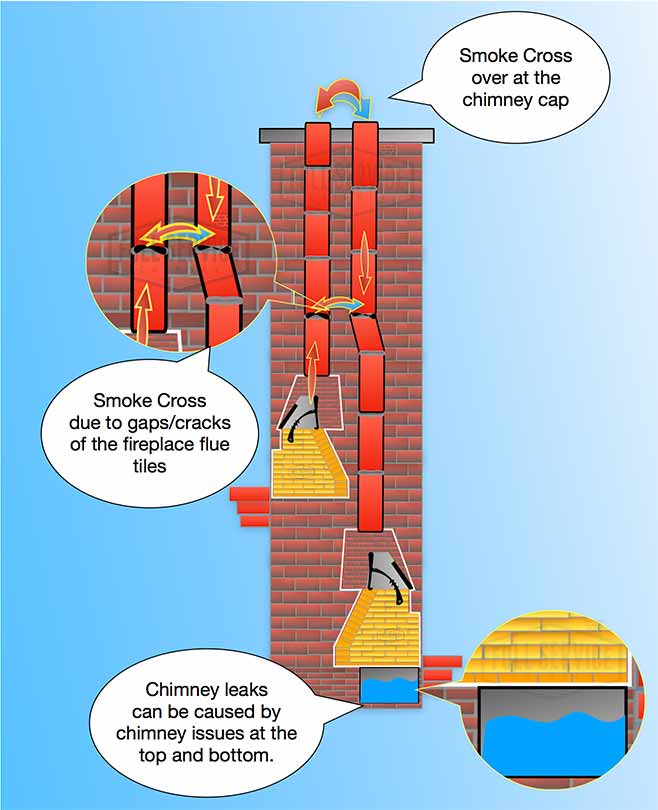A basement with a wood-burning fireplace is an attractive feature of any Kansas City area home. Often enjoyed with friends and family. However, basement fireplace problems are common, especially when compared to living rooms or master bedroom fireplaces.
Due to homes unique issues on lower level fireplaces, Full Service Chimney trains technicians on careful diagnosis and repair of basement fireplaces and their chimneys. Enjoyment of a basements’ fireplace can wane once the hearth shows signs of leaks or has a foul odor for example.
We understand these problems and can help.
Fireplace Cold Air Problem?
Cold air coming from the fireplace is a common issue in the basement, due to the lower levels of the home having lower inside pressure than that of the upper floors. Cold air entry from a basement fireplace peaks in the winter seasons (December to February in the Kansas City area) since these are the coldest months.
Backdrafting from basement fireplaces is a sign the home is using the lower fireplace as a source of fresh air. This happens to replace interior air being lost to the pressurized air above the neutral pressure plane.
We find on occasion, this back-drafting of the basement fireplace so extensive that it’s nearly impossible to enjoy fires down there. If your basement fireplace gives more cold than heat, contact the fireplace experts at Full Service Chimney.
By making the fireplace damper work properly, providing alternate makeup air for the home or installing a gas fireplace insert are only a few of the treatments that have helped homes just like yours.
If the basement fireplace and chimney have had wood fires in the past, a common problem is odor issues from the basement fireplace and chimney. Fireplace odor is no small problem, and is common with fireplaces on the lower level of the home, during the warm, humid months of the year. Chimney odor is common but smelly chimneys are more noticeable when the following conditions exist:
- Humid air-damp air makes anything smell worse
- Creosote-Soot and Ash have some odor, but nothing smells worse than creosote. Not only is creosote smelly, but it’s a chimney fire hazard as well.
Notice a stinky odor from your basement fireplace?
Start with a chimney cleaning and inspection by a certified professional.
If you need chimney & fireplace help in Kansas City, then call Full Service Chimney at 913-642-6171. Our Certified Chimney Sweeps will diagnose issues contributing to a stinky basement fireplace.
Basement Smells Like Smoke When Using Upstairs Fireplace
A common fireplace/chimney design is two fireplaces in one chimney chase (each with their own clay flue tile system). A frequent issue homes have is smoke in the basement when using the upstairs living room fireplace. This is because smoke is crossing over from the upper fireplace and getting sucked down the unused basement fireplace flue.
With your upstairs fireplace burning, it sends 250-500 cfm (cubic feet of air) out of your home. The home being relatively airtight, must get fresh air to make up the air going out.
Frequently the easiest entry for fresh air is the basement fireplace flue. Smoke can cross over from one fireplace flue to the other at the very top. Smoke cross over at the chimney cap is more frequent when both flues are close to each other and nearly the same height. But cross over also occurs BEFORE THE SMOKE REACHES THE CHIMNEY CAP!
Smoke cross over/downdraft can happen when there are holes/gaps/cracks in the chimney flue liner systems of your home’s fireplaces. This condition is becoming more and more frequent with the masonry chimney flues of Kansas City as they are getting older. The mortar joints become soft and fall away exposing holes. This will for sure let smoke pass from one fireplace flue liner to another in the concealed brick chimney.
Full Service chimney is the original Kansas City Certified Chimney sweep, and have been solving smokey downdrafts and cold drafts for more than 30 years.
Can a missing chimney cap or damaged flashing cause water in the fireplace in the basement?
Oh yes.
Chimney Leaks are a frustrating part of chimney and fireplace ownership. That’s because water can enter in one area, and show up in another. This is because water can “wick” though bricks and mortar of a chimney, literally the full length of the chimney stack. So water seen in the basement fireplace is often rainwater that enters a leaky chimney, soaks past the upper fireplaces and finally settles in the basement. However, not all basement fireplace leaks come from above the roofline.
If our basement and its fireplace are below ground level, the groundwater surrounding your home and chimney may find its way into your lowest fireplace. Groundwater leaking into the basement chimney is often seen in the firebox, ash pit, or on (and around) the outer hearth.
Careful diagnosis is required to determine the waters’ entry point. Understanding the root of the fireplaces problem is necessary to perform effective chimney repairs.







